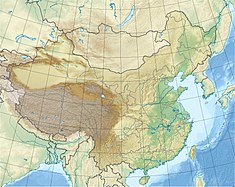| Lianghekou Dam | |
|---|---|
| Country | China |
| Location | Yajiang County, Sichuan Province |
| Coordinates | 30°11′49″N 101°00′38.98″E / 30.19694°N 101.0108278°E |
| Status | Complete |
| Construction began | 2009 |
| Opening date | 2021 |
| Owner(s) | Ertan Hydropower Development Company, Ltd |
| Dam and spillways | |
| Type of dam | Embankment, clay-core rock-fill |
| Impounds | Yalong River |
| Height | 295 m (968 ft) |
| Length | 650 m (2,133 ft) |
| Reservoir | |
| Creates | Lianghekou Reservoir |
| Total capacity | 10,767,000,000 m3 (8,728,949 acre⋅ft) |
| Catchment area | 65,200 km2 (25,174 sq mi) |
| Power Station | |
| Commission date | 18 March 2022[1] |
| Turbines | 6 x 500 MW Francis-type |
| Installed capacity | 3,000 MW |
The Lianghekou Dam (meaning: "mouth of two rivers") is a clay-core rockfill Embankment dam currently in operation on the Yalong River, a tributary of Yangtze River, in Yajiang County, Sichuan Province, China. The dam is located at the confluence of the Yalong, Xianshui and Qingda Rivers.[2] The 295 m (968 ft) tall dam is the highest embankment dam in the country and support a 3,000 MW power station.[3] Studies for the dam were completed between 2005 and 2009 with preliminary construction beginning that year.[4] Major works on the dam officially began in October 2014.[5] The first two generators were commissioned in September 2021[6] and the final unit was put in service in March 2022. With the reservoir's relatively large active capacity with respect to the river's annual flow, it can regulate the river flow across multiple years and increase the downstream hydroelectric power stations' output by smoothing out river flow peaks and troughs.
A Pumped-storage hydroelectricity plant of 1200 MW is under construction taking advantage of the large reservoir size. [7]
Over 4,900 people were relocated during the construction of the dam.[8]
There are several solar and wind projects that in operation (1,000 MW) or under construction (2,200 MW) near the dam taking advantage of the dam's existing power transmission system and the ability to regulate the hydroelectric power output compensating the variable renewable power output. [9]
- ^ "All units of Sichuan Lianghekou Hydropower Station are put into operation--Seetao".
- ^ "Lianghekou Hydroelectric Project". Ertan Hydropower Development Company, Ltd. Archived from the original on 13 March 2012. Retrieved 29 January 2011.
- ^ "Yalong River Hydropower Station Tender Notice" (in Chinese). CIEDR. 2009-12-22. Retrieved 29 January 2011.
- ^ "Lianghekou Hydropower Station" (in Chinese). Changjiang Water Resources Commission Ministry of Water Resources. Retrieved 29 January 2011.[permanent dead link]
- ^ "Tibetan largest hydropower invest 66.4 billion total in Ganzi start" (in Chinese). Sichuan Online. Retrieved 7 January 2015.
- ^ "China's highest-altitude mega hydropower plant, in occupied Tibet, goes into operation". 29 September 2021.
- ^ "Construction of large pumped-storage hydropower project starts in China's Sichuan".
- ^ Yunhua, Chen (2004). "HYDROELECTRIC EXPLOITATION AND SUSTAINABLE DEVELOPMENT OF THE YALONG RIVER" (PDF). UNHYDRO. Retrieved 29 January 2011.
- ^ "World's largest hydro-PV station now operating in China". 30 June 2023.
